SCU - ACC00724 Accounting for Managers: Financial Performance
VerifiedAdded on 2023/06/08
|11
|1159
|68
Homework Assignment
AI Summary
This assignment solution for ACC00724 Accounting for Managers includes a detailed financial analysis of Aristocrat Leisure Limited, focusing on key ratios such as debtor turnover, creditor turnover, and cash cycle. It also explores break-even analysis and profit maximization strategies for FreeWheels, evaluating different proposals to determine the most profitable option. Furthermore, the assignment addresses special order costing, calculating minimum bid prices based on varying production capacities and demand scenarios. The analysis incorporates variable and fixed costs to provide comprehensive recommendations for managerial decision-making.
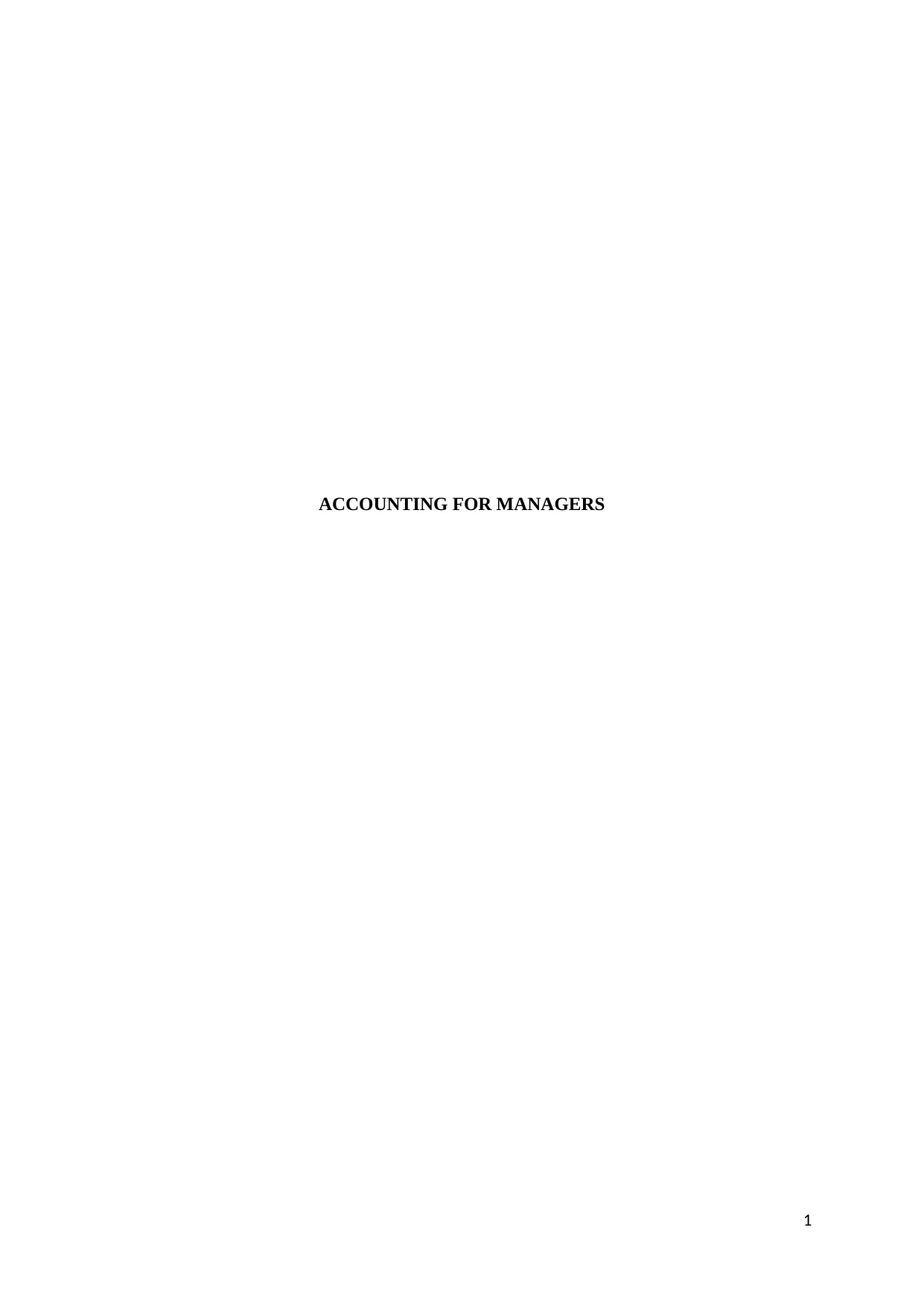
ACCOUNTING FOR MANAGERS
1
1
Paraphrase This Document
Need a fresh take? Get an instant paraphrase of this document with our AI Paraphraser
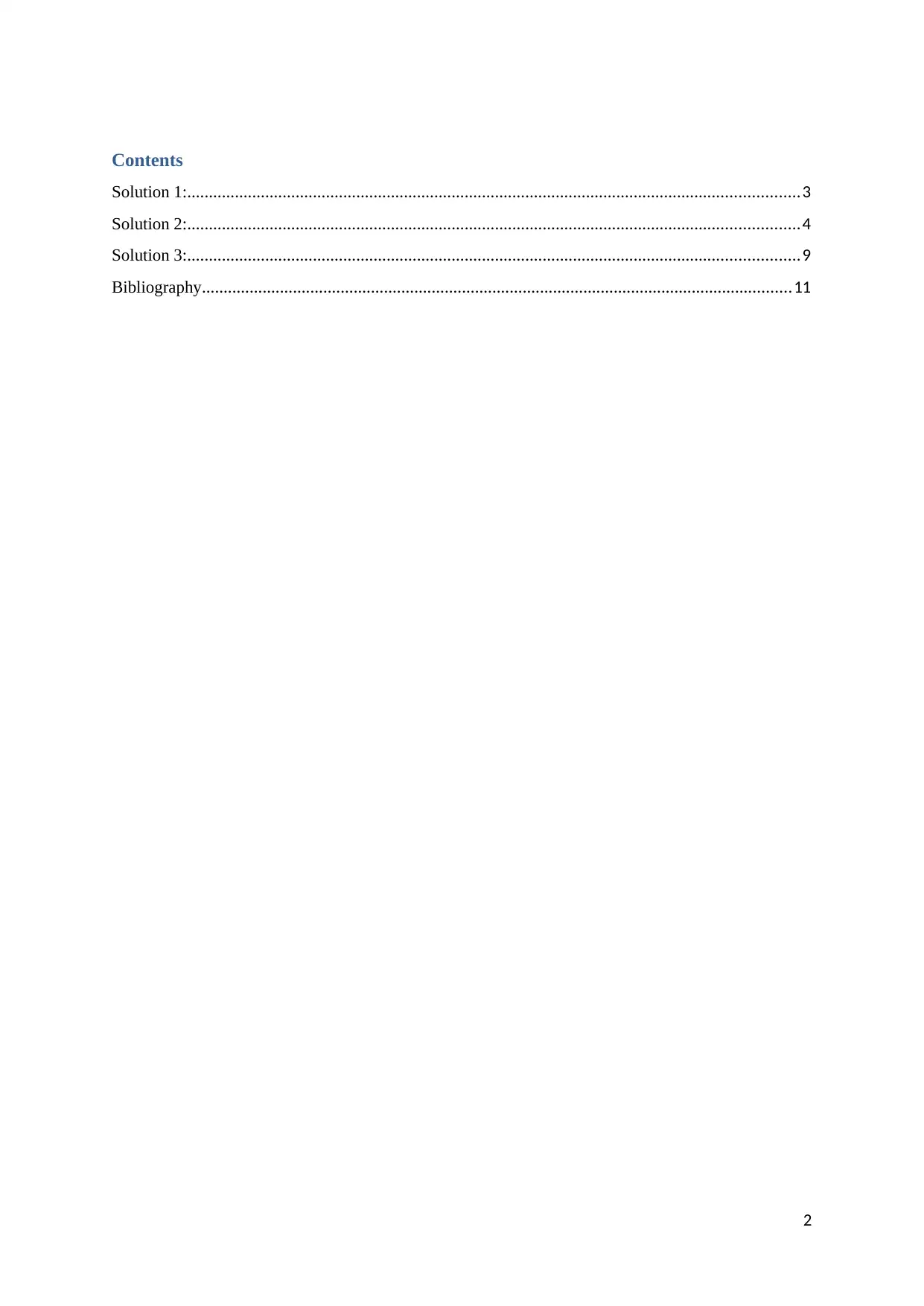
Contents
Solution 1:.............................................................................................................................................3
Solution 2:.............................................................................................................................................4
Solution 3:.............................................................................................................................................9
Bibliography........................................................................................................................................11
2
Solution 1:.............................................................................................................................................3
Solution 2:.............................................................................................................................................4
Solution 3:.............................................................................................................................................9
Bibliography........................................................................................................................................11
2
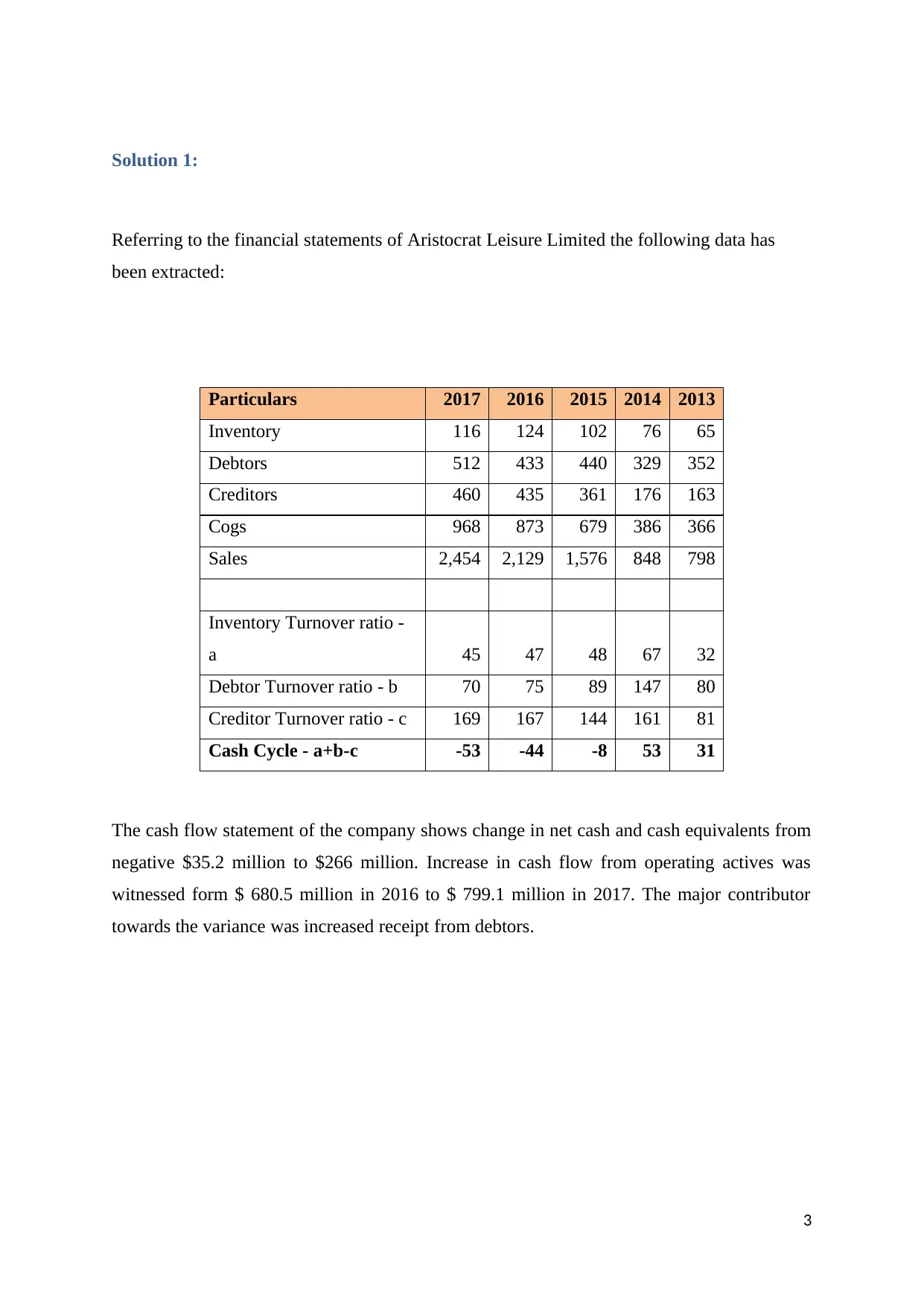
Solution 1:
Referring to the financial statements of Aristocrat Leisure Limited the following data has
been extracted:
Particulars 2017 2016 2015 2014 2013
Inventory 116 124 102 76 65
Debtors 512 433 440 329 352
Creditors 460 435 361 176 163
Cogs 968 873 679 386 366
Sales 2,454 2,129 1,576 848 798
Inventory Turnover ratio -
a 45 47 48 67 32
Debtor Turnover ratio - b 70 75 89 147 80
Creditor Turnover ratio - c 169 167 144 161 81
Cash Cycle - a+b-c -53 -44 -8 53 31
The cash flow statement of the company shows change in net cash and cash equivalents from
negative $35.2 million to $266 million. Increase in cash flow from operating actives was
witnessed form $ 680.5 million in 2016 to $ 799.1 million in 2017. The major contributor
towards the variance was increased receipt from debtors.
3
Referring to the financial statements of Aristocrat Leisure Limited the following data has
been extracted:
Particulars 2017 2016 2015 2014 2013
Inventory 116 124 102 76 65
Debtors 512 433 440 329 352
Creditors 460 435 361 176 163
Cogs 968 873 679 386 366
Sales 2,454 2,129 1,576 848 798
Inventory Turnover ratio -
a 45 47 48 67 32
Debtor Turnover ratio - b 70 75 89 147 80
Creditor Turnover ratio - c 169 167 144 161 81
Cash Cycle - a+b-c -53 -44 -8 53 31
The cash flow statement of the company shows change in net cash and cash equivalents from
negative $35.2 million to $266 million. Increase in cash flow from operating actives was
witnessed form $ 680.5 million in 2016 to $ 799.1 million in 2017. The major contributor
towards the variance was increased receipt from debtors.
3
⊘ This is a preview!⊘
Do you want full access?
Subscribe today to unlock all pages.

Trusted by 1+ million students worldwide
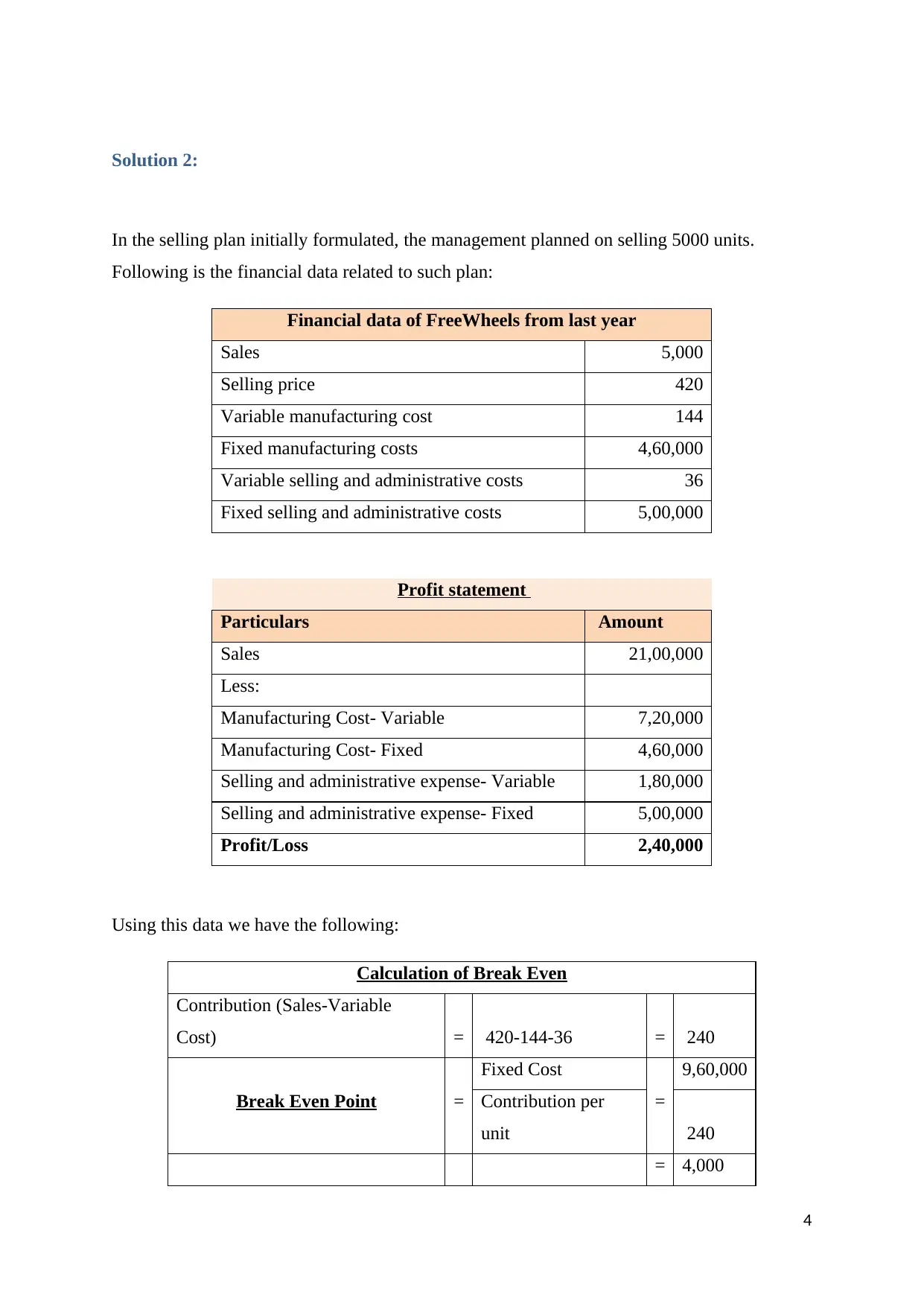
Solution 2:
In the selling plan initially formulated, the management planned on selling 5000 units.
Following is the financial data related to such plan:
Financial data of FreeWheels from last year
Sales 5,000
Selling price 420
Variable manufacturing cost 144
Fixed manufacturing costs 4,60,000
Variable selling and administrative costs 36
Fixed selling and administrative costs 5,00,000
Profit statement
Particulars Amount
Sales 21,00,000
Less:
Manufacturing Cost- Variable 7,20,000
Manufacturing Cost- Fixed 4,60,000
Selling and administrative expense- Variable 1,80,000
Selling and administrative expense- Fixed 5,00,000
Profit/Loss 2,40,000
Using this data we have the following:
Calculation of Break Even
Contribution (Sales-Variable
Cost) = 420-144-36 = 240
Break Even Point =
Fixed Cost
=
9,60,000
Contribution per
unit 240
= 4,000
4
In the selling plan initially formulated, the management planned on selling 5000 units.
Following is the financial data related to such plan:
Financial data of FreeWheels from last year
Sales 5,000
Selling price 420
Variable manufacturing cost 144
Fixed manufacturing costs 4,60,000
Variable selling and administrative costs 36
Fixed selling and administrative costs 5,00,000
Profit statement
Particulars Amount
Sales 21,00,000
Less:
Manufacturing Cost- Variable 7,20,000
Manufacturing Cost- Fixed 4,60,000
Selling and administrative expense- Variable 1,80,000
Selling and administrative expense- Fixed 5,00,000
Profit/Loss 2,40,000
Using this data we have the following:
Calculation of Break Even
Contribution (Sales-Variable
Cost) = 420-144-36 = 240
Break Even Point =
Fixed Cost
=
9,60,000
Contribution per
unit 240
= 4,000
4
Paraphrase This Document
Need a fresh take? Get an instant paraphrase of this document with our AI Paraphraser
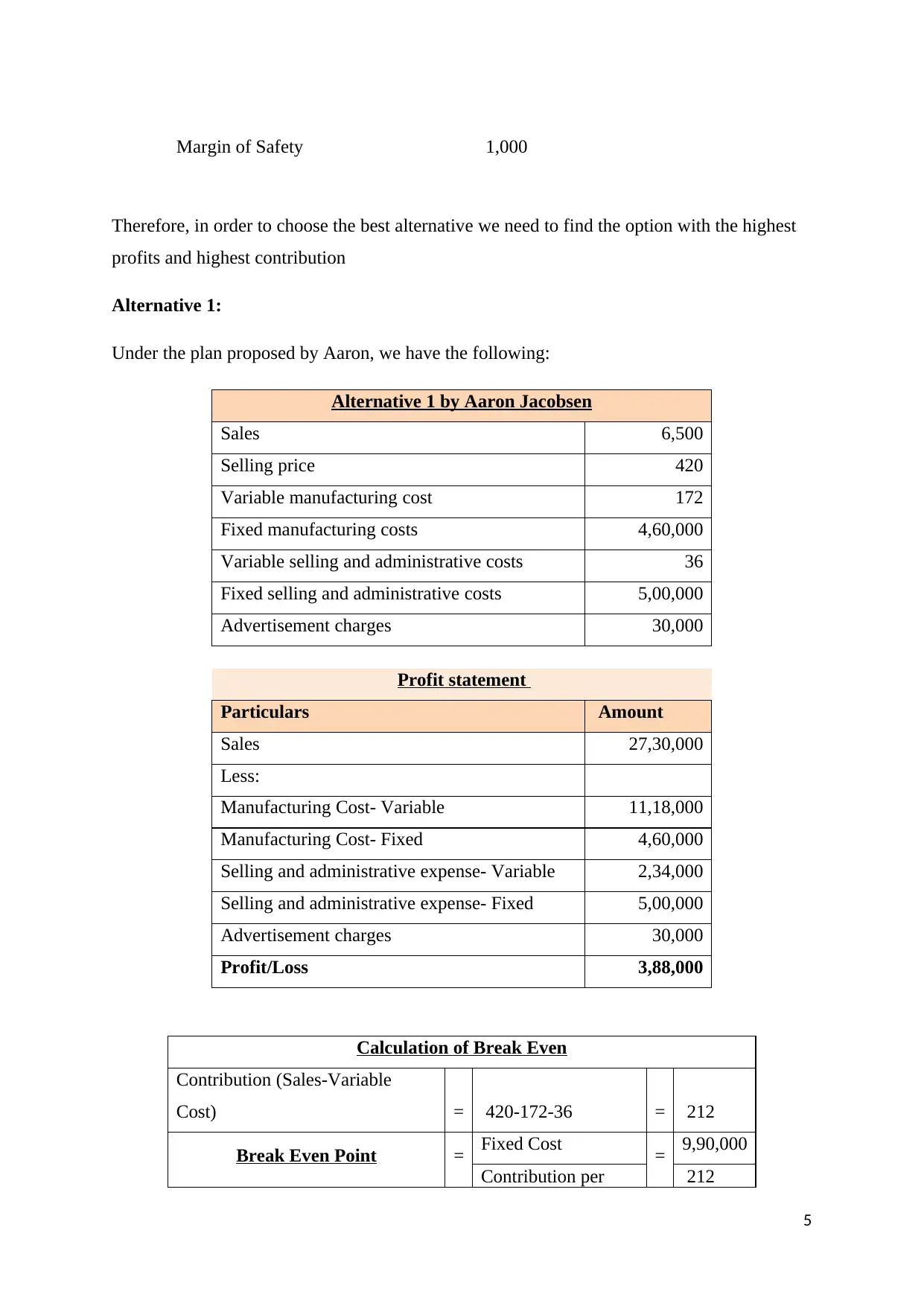
Margin of Safety 1,000
Therefore, in order to choose the best alternative we need to find the option with the highest
profits and highest contribution
Alternative 1:
Under the plan proposed by Aaron, we have the following:
Alternative 1 by Aaron Jacobsen
Sales 6,500
Selling price 420
Variable manufacturing cost 172
Fixed manufacturing costs 4,60,000
Variable selling and administrative costs 36
Fixed selling and administrative costs 5,00,000
Advertisement charges 30,000
Profit statement
Particulars Amount
Sales 27,30,000
Less:
Manufacturing Cost- Variable 11,18,000
Manufacturing Cost- Fixed 4,60,000
Selling and administrative expense- Variable 2,34,000
Selling and administrative expense- Fixed 5,00,000
Advertisement charges 30,000
Profit/Loss 3,88,000
Calculation of Break Even
Contribution (Sales-Variable
Cost) = 420-172-36 = 212
Break Even Point = Fixed Cost = 9,90,000
Contribution per 212
5
Therefore, in order to choose the best alternative we need to find the option with the highest
profits and highest contribution
Alternative 1:
Under the plan proposed by Aaron, we have the following:
Alternative 1 by Aaron Jacobsen
Sales 6,500
Selling price 420
Variable manufacturing cost 172
Fixed manufacturing costs 4,60,000
Variable selling and administrative costs 36
Fixed selling and administrative costs 5,00,000
Advertisement charges 30,000
Profit statement
Particulars Amount
Sales 27,30,000
Less:
Manufacturing Cost- Variable 11,18,000
Manufacturing Cost- Fixed 4,60,000
Selling and administrative expense- Variable 2,34,000
Selling and administrative expense- Fixed 5,00,000
Advertisement charges 30,000
Profit/Loss 3,88,000
Calculation of Break Even
Contribution (Sales-Variable
Cost) = 420-172-36 = 212
Break Even Point = Fixed Cost = 9,90,000
Contribution per 212
5
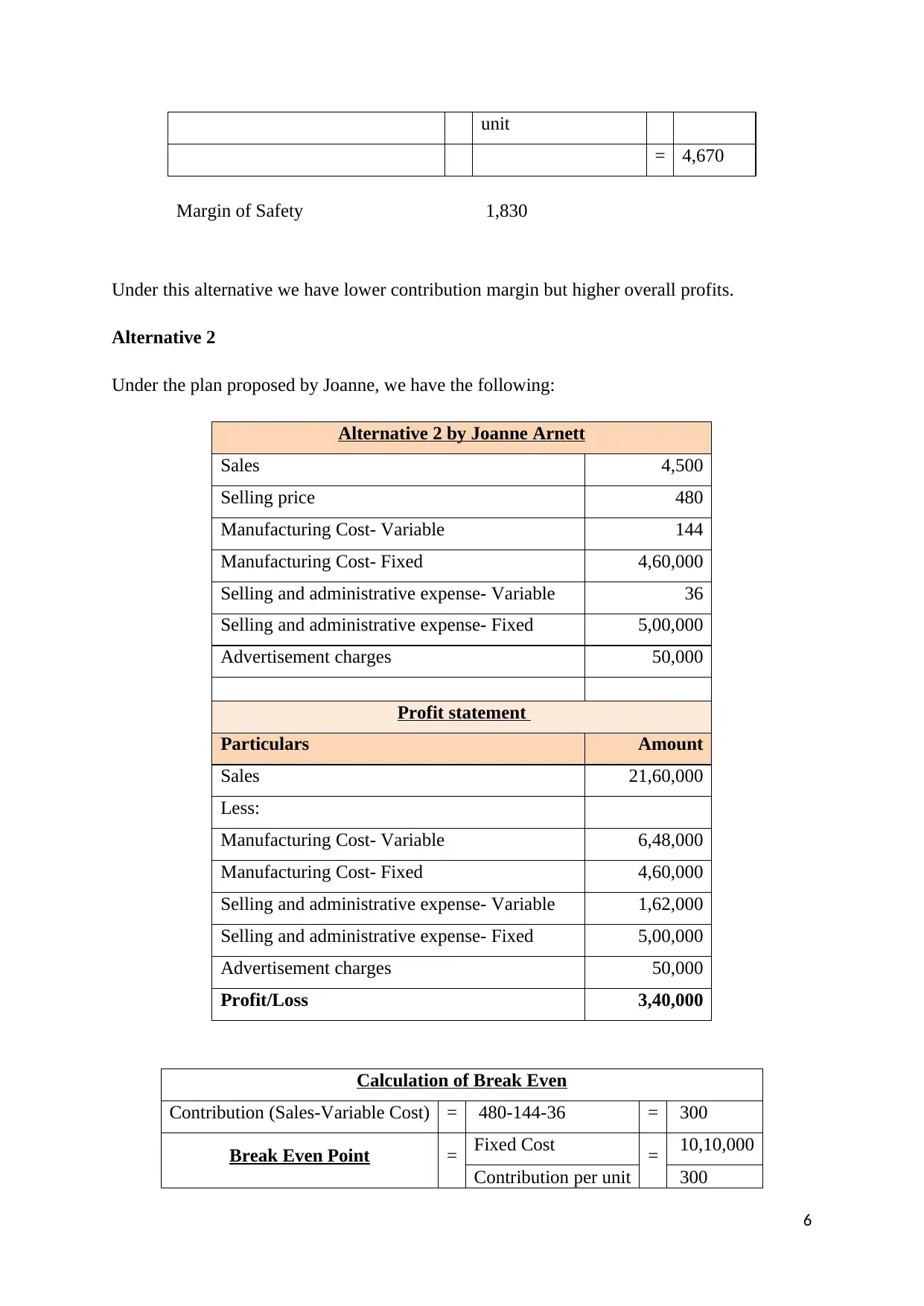
unit
= 4,670
Margin of Safety 1,830
Under this alternative we have lower contribution margin but higher overall profits.
Alternative 2
Under the plan proposed by Joanne, we have the following:
Alternative 2 by Joanne Arnett
Sales 4,500
Selling price 480
Manufacturing Cost- Variable 144
Manufacturing Cost- Fixed 4,60,000
Selling and administrative expense- Variable 36
Selling and administrative expense- Fixed 5,00,000
Advertisement charges 50,000
Profit statement
Particulars Amount
Sales 21,60,000
Less:
Manufacturing Cost- Variable 6,48,000
Manufacturing Cost- Fixed 4,60,000
Selling and administrative expense- Variable 1,62,000
Selling and administrative expense- Fixed 5,00,000
Advertisement charges 50,000
Profit/Loss 3,40,000
Calculation of Break Even
Contribution (Sales-Variable Cost) = 480-144-36 = 300
Break Even Point = Fixed Cost = 10,10,000
Contribution per unit 300
6
= 4,670
Margin of Safety 1,830
Under this alternative we have lower contribution margin but higher overall profits.
Alternative 2
Under the plan proposed by Joanne, we have the following:
Alternative 2 by Joanne Arnett
Sales 4,500
Selling price 480
Manufacturing Cost- Variable 144
Manufacturing Cost- Fixed 4,60,000
Selling and administrative expense- Variable 36
Selling and administrative expense- Fixed 5,00,000
Advertisement charges 50,000
Profit statement
Particulars Amount
Sales 21,60,000
Less:
Manufacturing Cost- Variable 6,48,000
Manufacturing Cost- Fixed 4,60,000
Selling and administrative expense- Variable 1,62,000
Selling and administrative expense- Fixed 5,00,000
Advertisement charges 50,000
Profit/Loss 3,40,000
Calculation of Break Even
Contribution (Sales-Variable Cost) = 480-144-36 = 300
Break Even Point = Fixed Cost = 10,10,000
Contribution per unit 300
6
⊘ This is a preview!⊘
Do you want full access?
Subscribe today to unlock all pages.

Trusted by 1+ million students worldwide
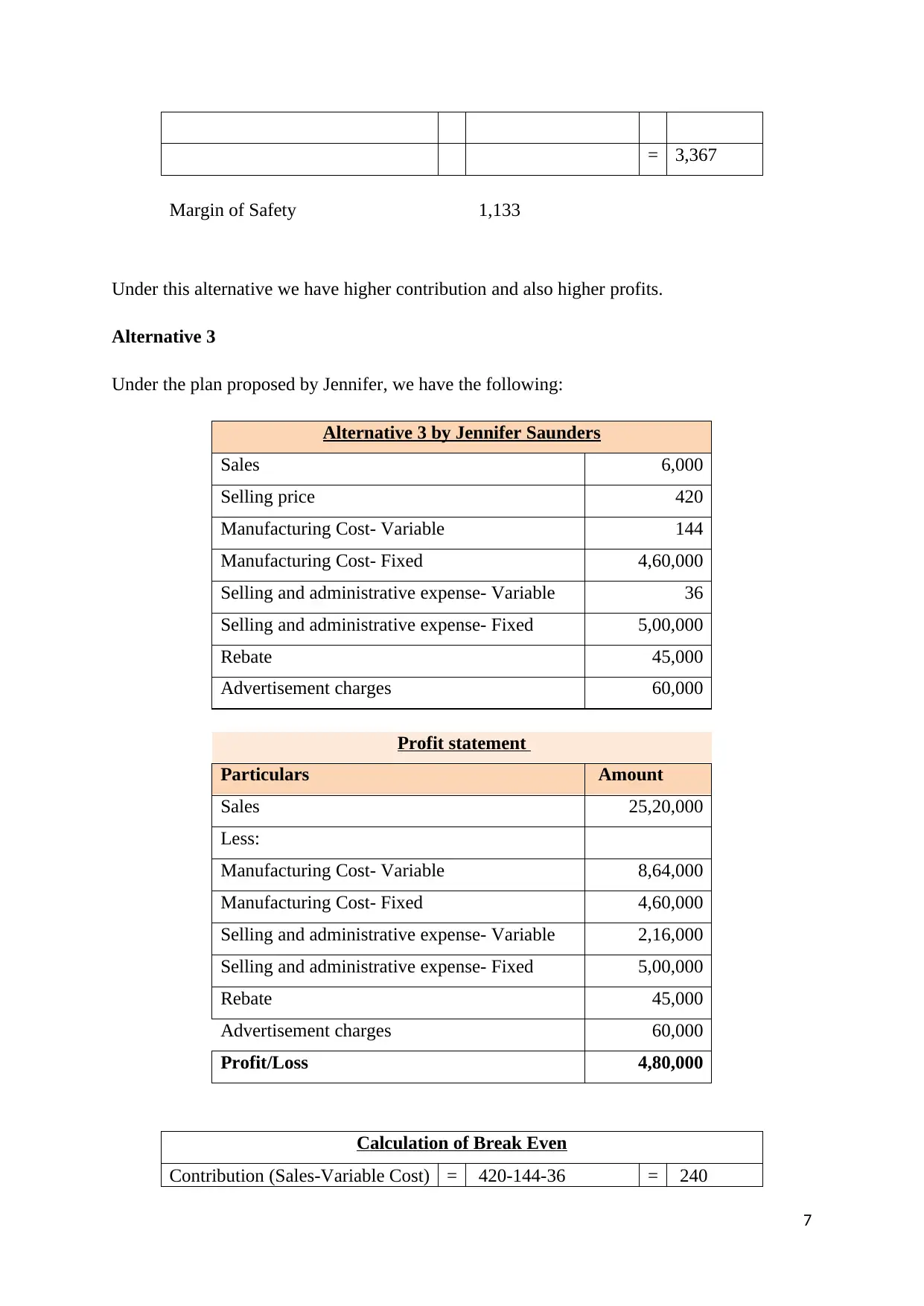
= 3,367
Margin of Safety 1,133
Under this alternative we have higher contribution and also higher profits.
Alternative 3
Under the plan proposed by Jennifer, we have the following:
Alternative 3 by Jennifer Saunders
Sales 6,000
Selling price 420
Manufacturing Cost- Variable 144
Manufacturing Cost- Fixed 4,60,000
Selling and administrative expense- Variable 36
Selling and administrative expense- Fixed 5,00,000
Rebate 45,000
Advertisement charges 60,000
Profit statement
Particulars Amount
Sales 25,20,000
Less:
Manufacturing Cost- Variable 8,64,000
Manufacturing Cost- Fixed 4,60,000
Selling and administrative expense- Variable 2,16,000
Selling and administrative expense- Fixed 5,00,000
Rebate 45,000
Advertisement charges 60,000
Profit/Loss 4,80,000
Calculation of Break Even
Contribution (Sales-Variable Cost) = 420-144-36 = 240
7
Margin of Safety 1,133
Under this alternative we have higher contribution and also higher profits.
Alternative 3
Under the plan proposed by Jennifer, we have the following:
Alternative 3 by Jennifer Saunders
Sales 6,000
Selling price 420
Manufacturing Cost- Variable 144
Manufacturing Cost- Fixed 4,60,000
Selling and administrative expense- Variable 36
Selling and administrative expense- Fixed 5,00,000
Rebate 45,000
Advertisement charges 60,000
Profit statement
Particulars Amount
Sales 25,20,000
Less:
Manufacturing Cost- Variable 8,64,000
Manufacturing Cost- Fixed 4,60,000
Selling and administrative expense- Variable 2,16,000
Selling and administrative expense- Fixed 5,00,000
Rebate 45,000
Advertisement charges 60,000
Profit/Loss 4,80,000
Calculation of Break Even
Contribution (Sales-Variable Cost) = 420-144-36 = 240
7
Paraphrase This Document
Need a fresh take? Get an instant paraphrase of this document with our AI Paraphraser
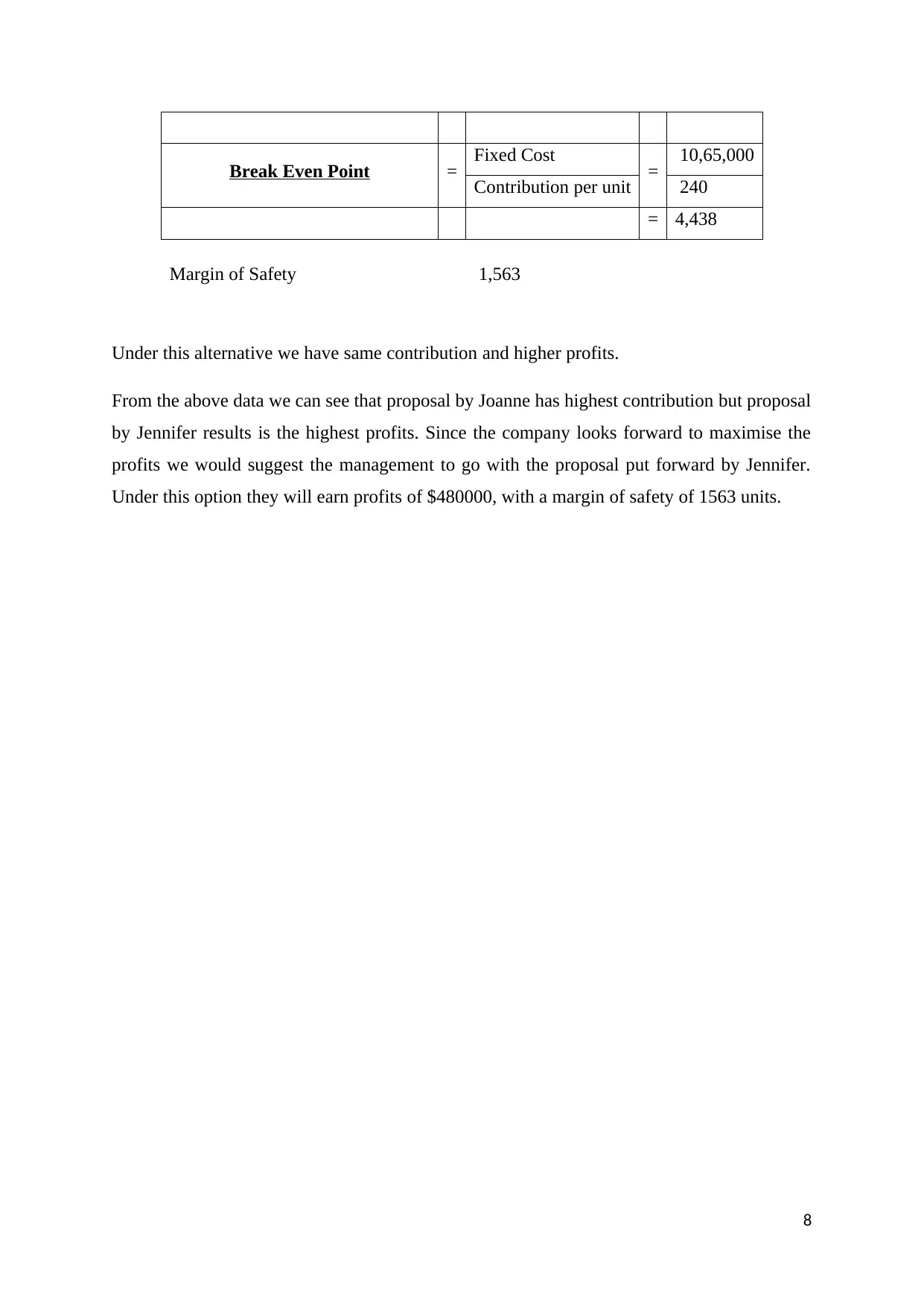
Break Even Point = Fixed Cost = 10,65,000
Contribution per unit 240
= 4,438
Margin of Safety 1,563
Under this alternative we have same contribution and higher profits.
From the above data we can see that proposal by Joanne has highest contribution but proposal
by Jennifer results is the highest profits. Since the company looks forward to maximise the
profits we would suggest the management to go with the proposal put forward by Jennifer.
Under this option they will earn profits of $480000, with a margin of safety of 1563 units.
8
Contribution per unit 240
= 4,438
Margin of Safety 1,563
Under this alternative we have same contribution and higher profits.
From the above data we can see that proposal by Joanne has highest contribution but proposal
by Jennifer results is the highest profits. Since the company looks forward to maximise the
profits we would suggest the management to go with the proposal put forward by Jennifer.
Under this option they will earn profits of $480000, with a margin of safety of 1563 units.
8
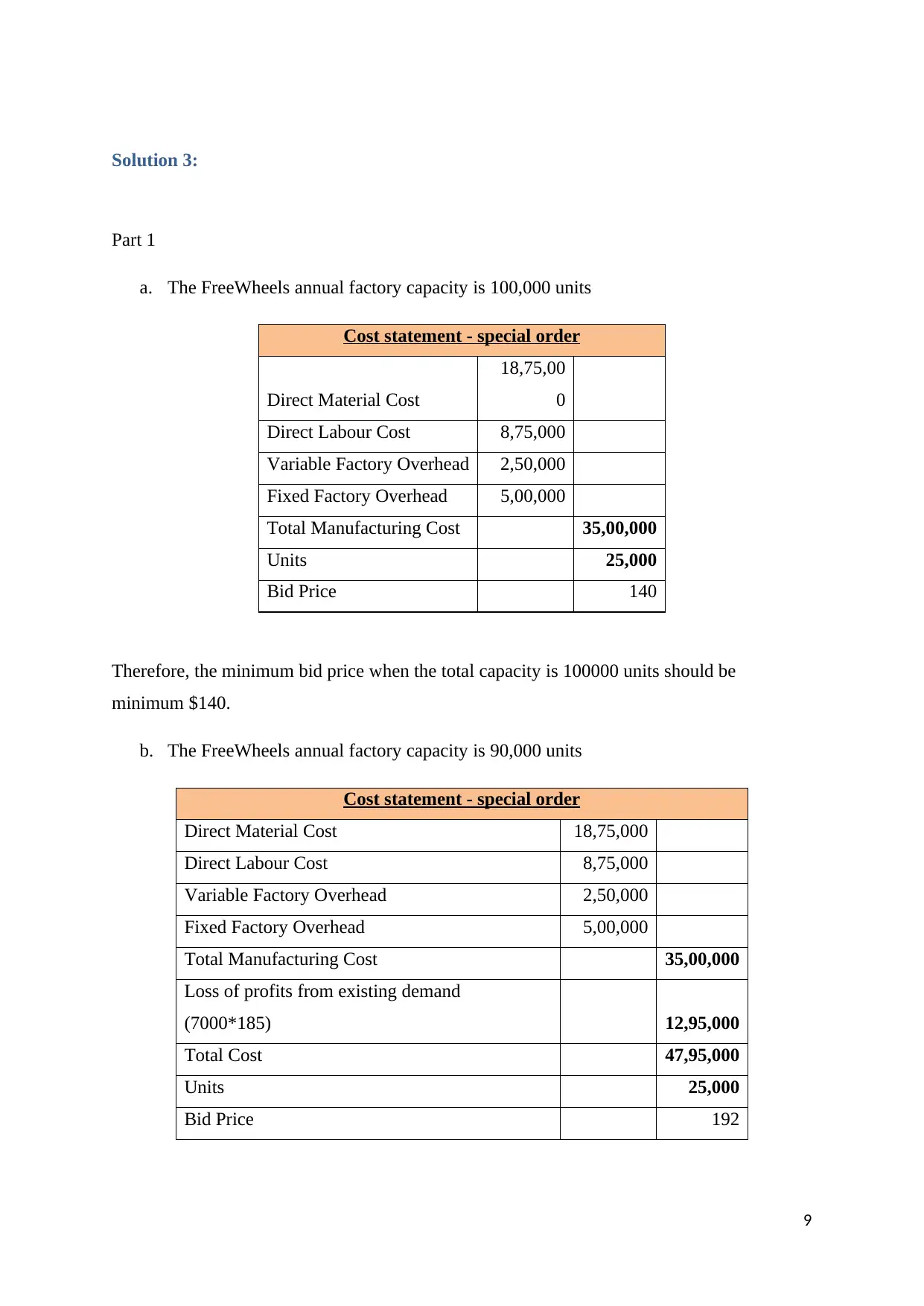
Solution 3:
Part 1
a. The FreeWheels annual factory capacity is 100,000 units
Cost statement - special order
Direct Material Cost
18,75,00
0
Direct Labour Cost 8,75,000
Variable Factory Overhead 2,50,000
Fixed Factory Overhead 5,00,000
Total Manufacturing Cost 35,00,000
Units 25,000
Bid Price 140
Therefore, the minimum bid price when the total capacity is 100000 units should be
minimum $140.
b. The FreeWheels annual factory capacity is 90,000 units
Cost statement - special order
Direct Material Cost 18,75,000
Direct Labour Cost 8,75,000
Variable Factory Overhead 2,50,000
Fixed Factory Overhead 5,00,000
Total Manufacturing Cost 35,00,000
Loss of profits from existing demand
(7000*185) 12,95,000
Total Cost 47,95,000
Units 25,000
Bid Price 192
9
Part 1
a. The FreeWheels annual factory capacity is 100,000 units
Cost statement - special order
Direct Material Cost
18,75,00
0
Direct Labour Cost 8,75,000
Variable Factory Overhead 2,50,000
Fixed Factory Overhead 5,00,000
Total Manufacturing Cost 35,00,000
Units 25,000
Bid Price 140
Therefore, the minimum bid price when the total capacity is 100000 units should be
minimum $140.
b. The FreeWheels annual factory capacity is 90,000 units
Cost statement - special order
Direct Material Cost 18,75,000
Direct Labour Cost 8,75,000
Variable Factory Overhead 2,50,000
Fixed Factory Overhead 5,00,000
Total Manufacturing Cost 35,00,000
Loss of profits from existing demand
(7000*185) 12,95,000
Total Cost 47,95,000
Units 25,000
Bid Price 192
9
⊘ This is a preview!⊘
Do you want full access?
Subscribe today to unlock all pages.

Trusted by 1+ million students worldwide
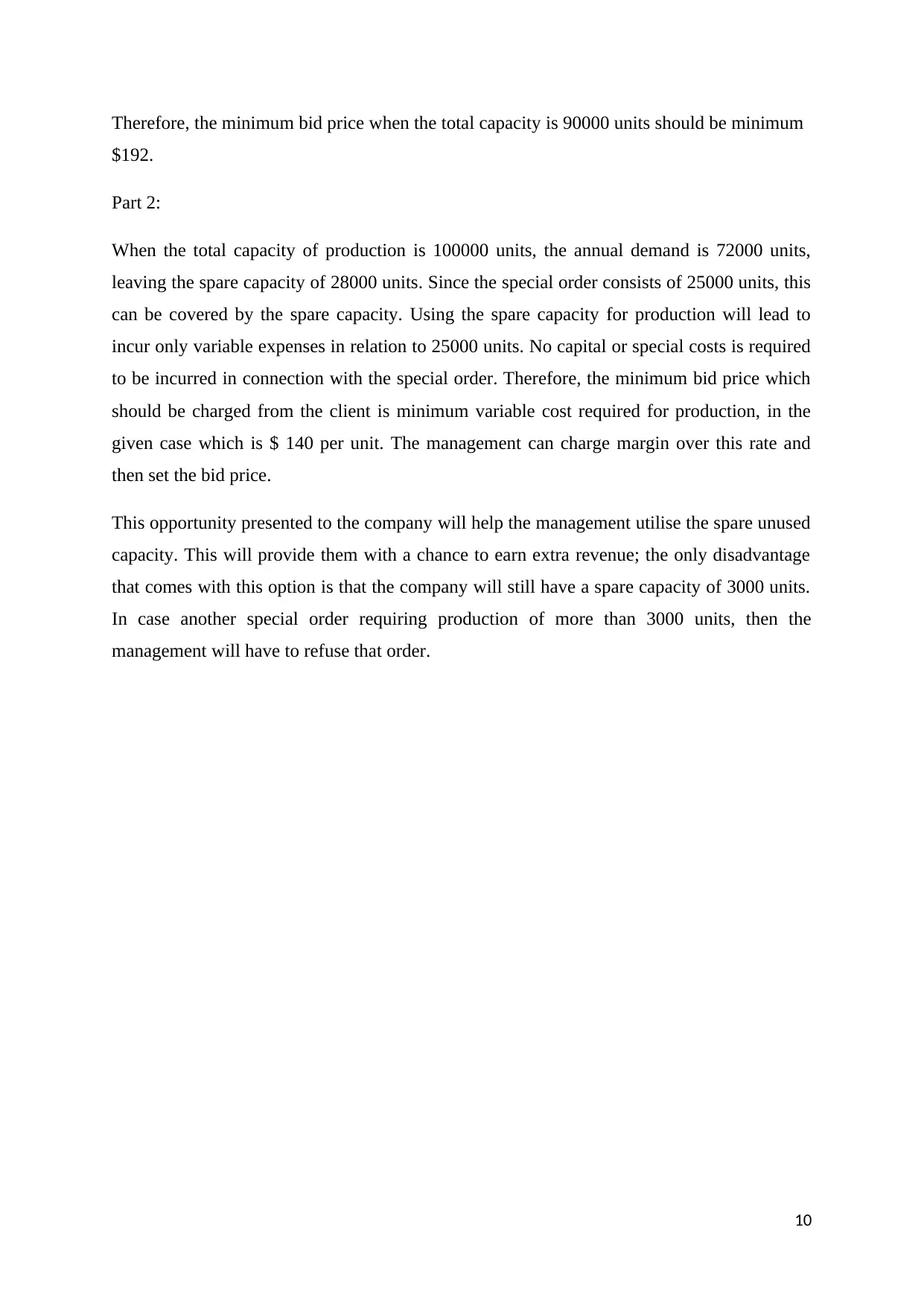
Therefore, the minimum bid price when the total capacity is 90000 units should be minimum
$192.
Part 2:
When the total capacity of production is 100000 units, the annual demand is 72000 units,
leaving the spare capacity of 28000 units. Since the special order consists of 25000 units, this
can be covered by the spare capacity. Using the spare capacity for production will lead to
incur only variable expenses in relation to 25000 units. No capital or special costs is required
to be incurred in connection with the special order. Therefore, the minimum bid price which
should be charged from the client is minimum variable cost required for production, in the
given case which is $ 140 per unit. The management can charge margin over this rate and
then set the bid price.
This opportunity presented to the company will help the management utilise the spare unused
capacity. This will provide them with a chance to earn extra revenue; the only disadvantage
that comes with this option is that the company will still have a spare capacity of 3000 units.
In case another special order requiring production of more than 3000 units, then the
management will have to refuse that order.
10
$192.
Part 2:
When the total capacity of production is 100000 units, the annual demand is 72000 units,
leaving the spare capacity of 28000 units. Since the special order consists of 25000 units, this
can be covered by the spare capacity. Using the spare capacity for production will lead to
incur only variable expenses in relation to 25000 units. No capital or special costs is required
to be incurred in connection with the special order. Therefore, the minimum bid price which
should be charged from the client is minimum variable cost required for production, in the
given case which is $ 140 per unit. The management can charge margin over this rate and
then set the bid price.
This opportunity presented to the company will help the management utilise the spare unused
capacity. This will provide them with a chance to earn extra revenue; the only disadvantage
that comes with this option is that the company will still have a spare capacity of 3000 units.
In case another special order requiring production of more than 3000 units, then the
management will have to refuse that order.
10
Paraphrase This Document
Need a fresh take? Get an instant paraphrase of this document with our AI Paraphraser
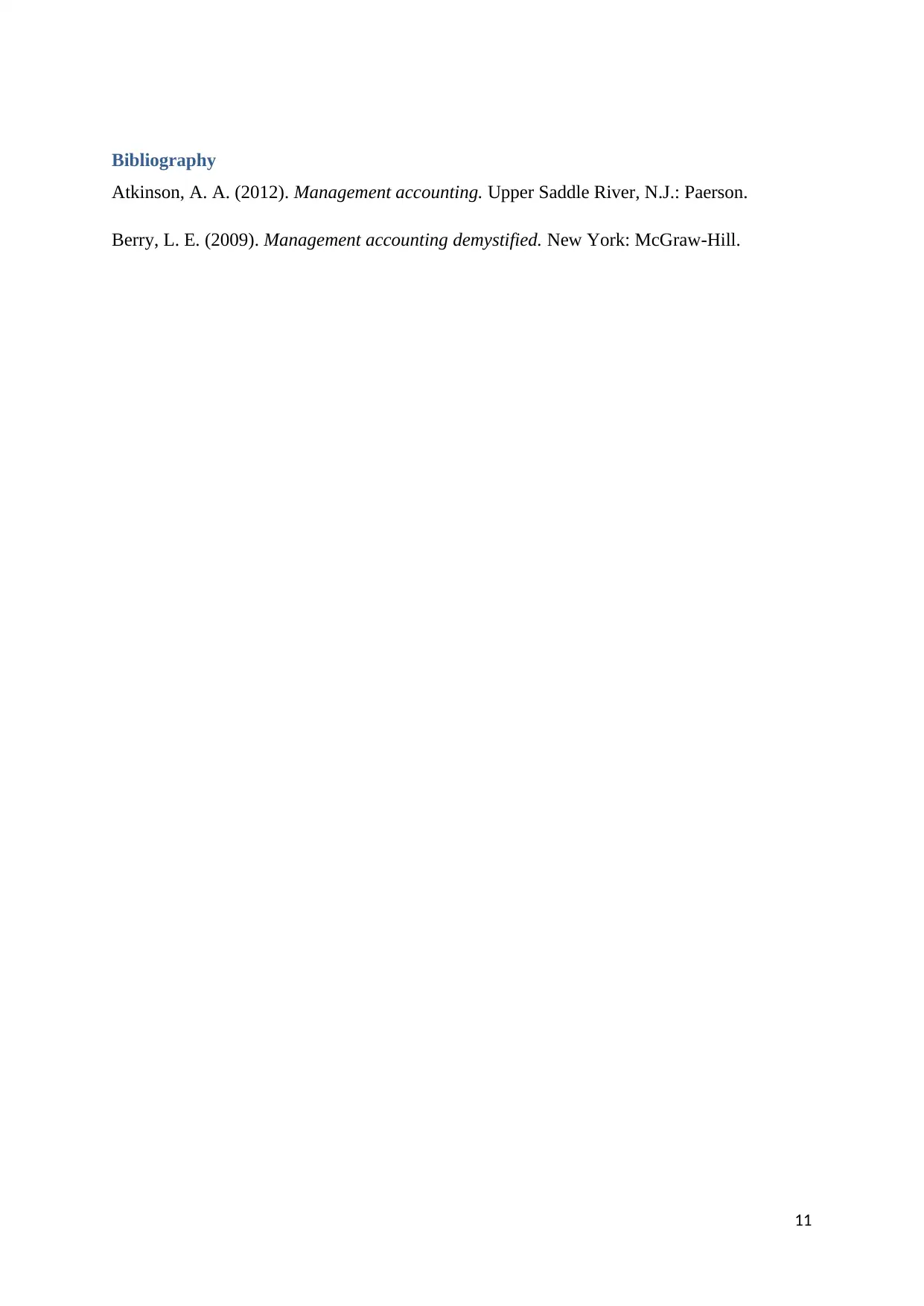
Bibliography
Atkinson, A. A. (2012). Management accounting. Upper Saddle River, N.J.: Paerson.
Berry, L. E. (2009). Management accounting demystified. New York: McGraw-Hill.
11
Atkinson, A. A. (2012). Management accounting. Upper Saddle River, N.J.: Paerson.
Berry, L. E. (2009). Management accounting demystified. New York: McGraw-Hill.
11
1 out of 11
Related Documents
Your All-in-One AI-Powered Toolkit for Academic Success.
+13062052269
info@desklib.com
Available 24*7 on WhatsApp / Email
![[object Object]](/_next/static/media/star-bottom.7253800d.svg)
Unlock your academic potential
Copyright © 2020–2025 A2Z Services. All Rights Reserved. Developed and managed by ZUCOL.




